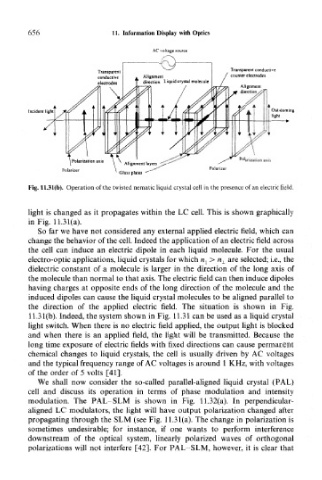Page 672 - Introduction to Information Optics
P. 672
656 11. Information Display with Optics
AC voltage source
Transparent conductive
Alignment counter electrodes
direction Liquid crystal molecule
Incident light
Polarization axis
\ Polarization axis
Polarizer
Fig. 11.31(b). Operation of the twisted nematic liquid crystal cell in the presence of an electric field.
light is changed as it propagates within the LC cell. This is shown graphically
in Fig. 11.31(a).
So far we have not considered any external applied electric field, which can
change the behavior of the cell. Indeed the application of an electric field across
the cell can induce an electric dipole in each liquid molecule. For the usual
electro-optic applications, liquid crystals for which « t, >n L are selected; i.e., the
dielectric constant of a molecule is larger in the direction of the long axis of
the molecule than normal to that axis. The electric field can then induce dipol.es
having charges at opposite ends of the long direction of the molecule and the
induced dipoles can cause the liquid crystal molecules to be aligned parallel to
the direction of the applied electric field. The situation is shown in Fig.
11.31(b). Indeed, the system shown in Fig. 11.31 can be used as a liquid crystal
light switch. When there is no electric field applied, the output light is blocked
and when there is an applied field, the light will be transmitted. Because the
long time exposure of electric fields with fixed directions can cause permanent
chemical changes to liquid crystals, the cell is usually driven by AC voltages
and the typical frequency range of AC voltages is around 1 KHz, with voltages
of the order of 5 volts [41].
We shall now consider the so-called parallel-aligned liquid crystal (PAL)
cell and discuss its operation in terms of phase modulation and intensity
modulation. The PAL-SLM is shown in Fig. 11.32(a). In perpendicular-
aligned LC modulators, the light will have output polarization changed after
propagating through the SLM (see Fig. 11.31 (a). The change in polarization is
sometimes undesirable; for instance, if one wants to perform interference
downstream of the optical system, linearly polarized waves of orthogonal
polarizations will not interfere [42], For PAL-SLM, however, it is clear that

